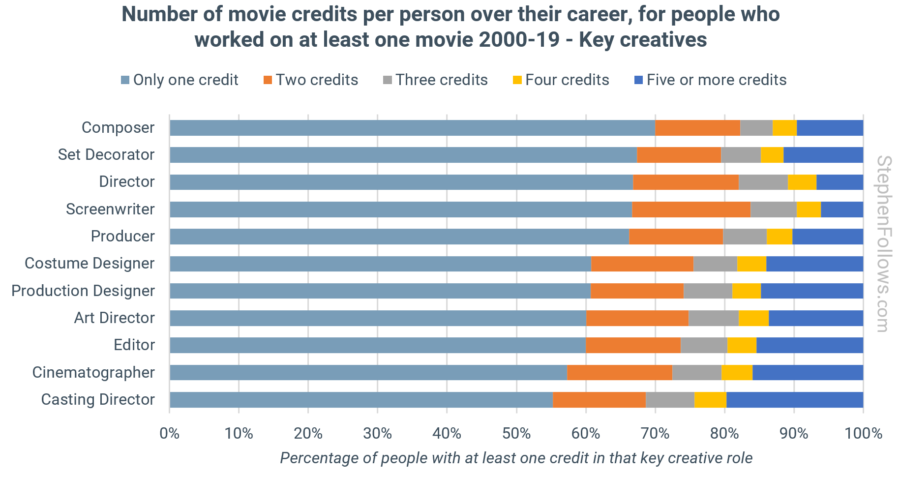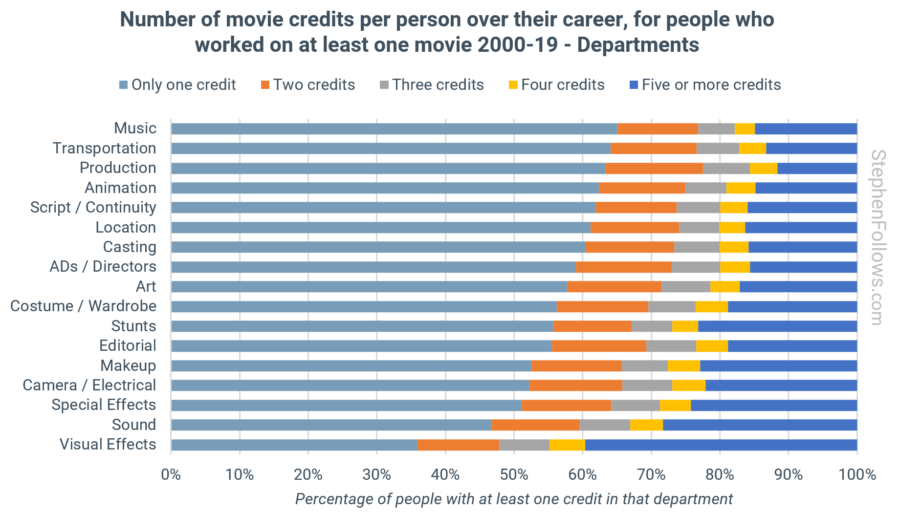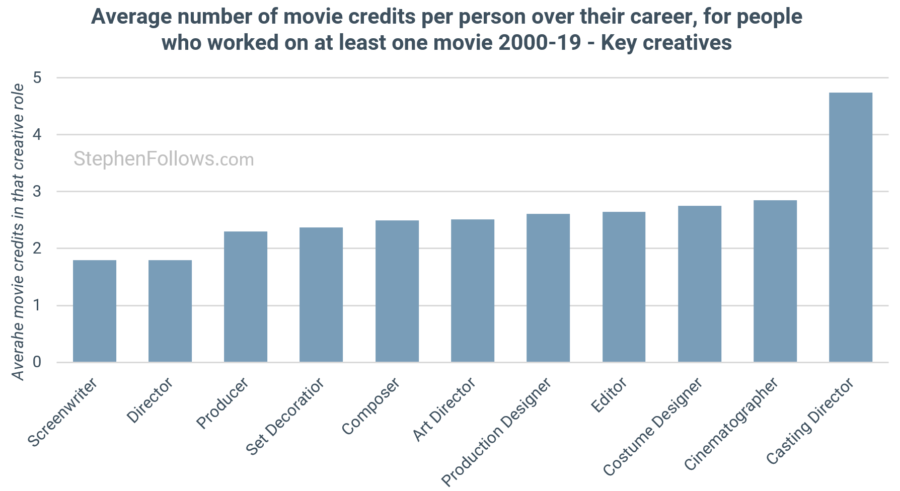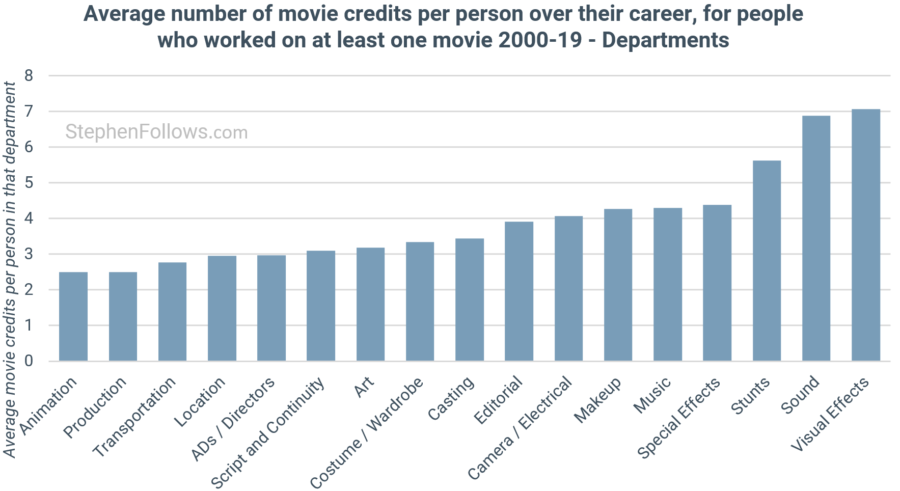
Many outsiders to the movie industry would regard the chance to be part of the crew making a movie as a once in a lifetime experience. Little do they know, for the majority of people who actually get that chance, it quite literally is!
I have written before about how only about a third of writers, producers and directors get the chance to make a second film. Today, I am answering a question from a reader who got in touch to ask how frequent mono-credits are in other jobs and departments.
To answer this question, I looked at the movie careers of 507,516 people who had at least one crew credit on a movie released in US cinemas between 2000 and 2019. There is more detail on my criteria and methodology at the end of the article.
How many people receive just one credit?
Let’s start by looking at key creatives and then move on to other jobs and departments.
Film composers are least likely to be hired more than once, with 70% only receiving one movie credit. They’re followed closely by set decorators (67%), directors (67%), writers (67%) and producers (66%). Casting directors have the highest levels of recidivism, but even they have a 55% one-and-done rate.

Let’s widen out to the whole crew, looking at the different departments. In line with what we saw above, people working in the music department are the least likely to work in film again, with 65% only receiving one credit. At the other end of the spectrum is the visual effects department, where just under two thirds of people receive two or more credits.

It’s worth reminding ourselves that this research is looking at films which made it to US cinemas. I.e. they were funded, finished and distributed. Only a few percent of the films made in the world manage to get this far. But despite being among the more successful titles, the majority of their crew (51.4%) will not work on another movie.
Average number of movie credits
Using the same data we can look at a related question – how many credits does the average person receive throughout their career?
Casting Directors have the highest, with an average of 4.7 movie credits per person. At the other end we see writers (1.8), directors (1.8) and producers (2.3).

Crew members in the visual effects department have the greatest number of credits per person (7.1) This is measuring publicly declared credits so I suspect the real number is slightly higher, given that studios are notoriously patchy in ensuring that everyone who worked on a movie’s visual effects receives a name check.

Notes
Today’s research looks at the movie credits of people who had at least one crew credit in a movie released theatrically in North America between 1st January 2000 and 31st December 2019. Once I had my list of people, I went back and looked at all their movie credits, even those released before 2000, in order to ensure I was assessing their career to date.
Raw credit data came from a number of public sources, including IMDB, Wikipedia and Movie Insider.
This does not take into account work in other mediums, such as TV, music videos, online videos, etc.
This research treats all credits the same as it cannot take account of the length of time worked, seniority, the amount paid, etc. Given the unbalanced nature of the industry, it’s certainly possible to be successful in ways which do not show up in simple credits counts. These include being the writer of unproduced (but optioned) scripts, being hired infrequently but paid handsomely, uncredited work, etc.





Comments
First of all Stephen I must thank you for the interesting work you do. Your latest article regarding credits should come with a caviat – I worked in the UK camera department rising up through the ranks from Loader to DP before having my own production company. There were no credits for camera assistants until the late 60s and 70s, so all of the “junior grades” were not even mentioned until then. In keeping with most free lance technicians, I did not spend all my time waiting for the next movie, I worked on TV commercials, documentaries (golf shows) etc making a very good living. So your reply to the lay people should include that message. Kind regards Brian Harris on IMDB Brian Harris (i)
Stephen
Crew credits On IMDB are not necessarily an accurate representation of a career.
Yes, for ATL.
But, it gets a bit more complex BTL.
For every BTL credit in IMDB there is probably at least one other person who who worked in that department in a significant role, who does not get a credit.
Hi Nick
Thanks for adding your thoughts. Yes, that something I’ve been trying to get a figure on for a while. The data didn’t just come from IMDb but all such sources suffer from the same position of only being able to publish what they’re told (i.e. they don’t do primary research). Studios submit “locked” credit lists but these are very often missing some names. VFX is an area I often highlight as vendors are often told their quota for how many names they can submit for the official credits, ignoring completely that that’s not how the industry actually works!
IMDb functions as a useful seemingly-independent repository of professional CVs for many crew members and so if they are missed off, many will submit missed credits themselves. I looked at this a few years back https://stephenfollows.com/uncredited-movie-credits/. Even given this, I would still think it undercounts the true number of credits each person has, as after a certain number it doesn’t really matter. Once you’re experienced in a role then your relationships will be what gets you work.
It’s hard to get a true reading on what this under-count is. The best solution would be a widespread survey of crewmembers at all levels, asking something akin to “How does your IMDb et al CV compare to your true CV?”.
The thrust of today’s piece is around single-credited people and that’s a different case to whether IMDb et al is a comprehensive list. Getting your first few credits on IMDb is a writ of passage and proof (to yourself and others) that you’re really working on movies. I think it’s certainly possible that someone with 50 credits should have 52, 55 or even 60. But I don’t think that many of the people who have one credit really have two. It takes more than one credit to get ambivalent about recognition. But this is an assumption, and so until we have data to answer it, we all need to take on board this potential skew/bias.
Stephen…have you done any analysis of UK feature credits (including US-funded projects)? The numbers in this piece of work seem (based on my gut feeling and experience) pretty off-target. One thing that stands out is the number of HoDs who apparently do fewer than three films in their career. If you had only 2-3 films under your belt by pension age at HoD level you would normally have left the industry long before then.
Hi Tony
Thanks for adding your perspective; certainly one which I value, given your experience in BECTU.
I have gone back to check the data and the numbers are sound. I checked the calculations and spot-checked a few years in more detail to be sure.
Two possible reasons it may run counter to your experience are the nature of films studied and what we’re all reading between the lines.
Firstly, the criteria for the study was films released in US cinemas. While the box office gross is dominated by a small number of films, the raw numbers of films released are dominated by much smaller films which often go largely unnoticed. These are most likely small budget, indie movies in which there will be less union presence and less experienced people in some roles. (That’s not to denigrate them – it’s a great way to learn, they may still be great films).
Secondly, it is natural to assume that “only performing a role once” is automatically some form of failure. I don’t think that’s fair for most of the mon-credited people in this study. A random check of the ‘single-credited’ reveals that they often have received credits in other roles or departments and/or some in another medium.
To build a bridge between your perspective and the results, let’s look at how the numbers play out. Hypothetically, if we had a year in which just forty films were released. Of those:
• Half the movies had an experienced editor, with ten editors each editing two of the movies that year
• A quarter had editors from other fields or roles, such as having edited major TV shows or worked as an assistant editor of major movies
• A quarter had people who were catching their big break into movies on self-funded, boot-strapped productions.
That means that at least three-quarters of the movies had an editor who was experienced in the job (and among all on the biggest, best-known movies) yet out of the 30 individuals with at least one editing credit, 66% had just one credit.
This is just a made-up example to show how the power law of attention in the industry can lead to things feeling off, while still being the case.
Does it count for those of us with shifting film credits? IE — Key Makeup (3) Special FX – (1 ) AD(1) Producer (1) or do we just muck up your data because we couldn’t make up our mind? ( or were willing to work in other spots ). I only counted the ones that met the criteria of distributed. ( other wise that number goes up to 14 features). Here is another question – how many of us flexible types are out there?
Thanks for sharing.
Good point, Sandra. I’m much the same with main listed credits being Editorial (2), Visual Effects (2), Camera Dept (1), and Producer (1), meeting the criteria, but I’ve done a lot more work that never makes it to IMDB like documentaries, music video, short films, etc. It would be an interesting data set to look at how many of us are more flexible in skills.
Nice…but you missed something big…BIG…in your analysis. You appear to skip Grip, Electric, Sound, Teamsters, Set Dec, Props, Wardrobe, Assistant Directors, Production Assistants, Camera, Locations…and others. They’re “Crew” and *not kidding* virtually all of the people I work with on a regular, recurring basis are credited in multiple shows. It’s their career, Bro.
Hi Doug. Fear not – they are all included in the department level stats. This is how IMDb groups roles. While it’s not perfect, it is a useful way to look at the across all crew members, If I split out every single job role then the results are too voluminous and edges cases dominate.